1993 PONTIAC BONNEVILLE tire pressure
[x] Cancel search: tire pressurePage 112 of 322
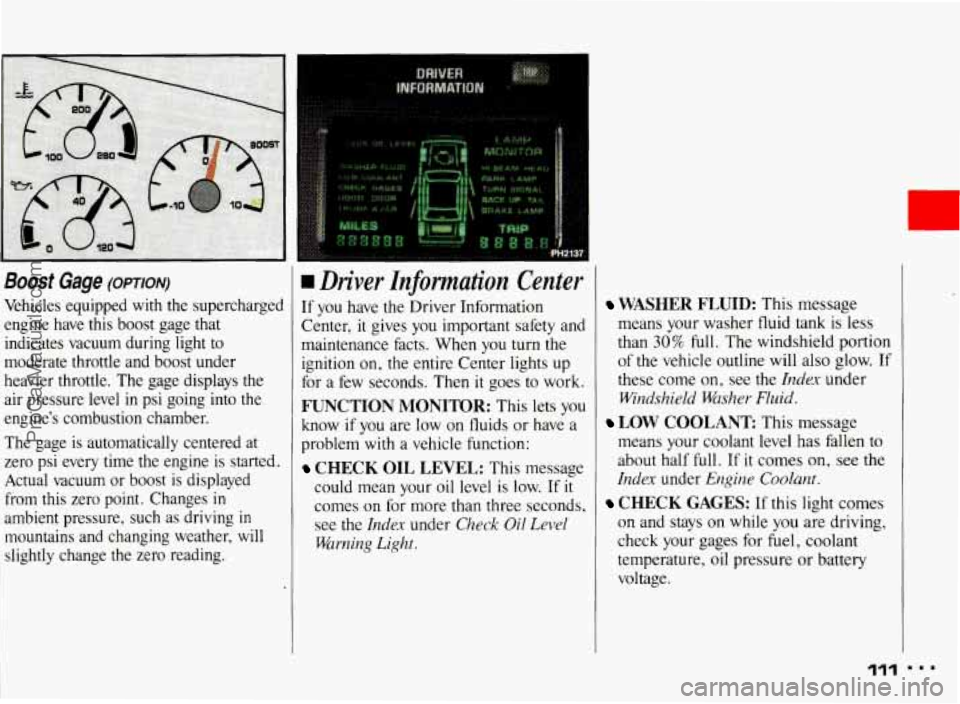
Boost Gage (OPTION)
Vehicles equipped with the supercharged
engine have this boost gage that indicates vacuum during light to
moderate throttle and boost under
heavier throttle. The gage displays the
air pressure level
in psi going into the
engine’s combustion chamber.
The gage is automatically centered at
zero psi
every time the engine is started.
Actual vacuum or boost
is displayed
from this zero point. Changes
in
ambient pressure, such as driving in
mountains and changing weather, will slightly change
the zero reading.
I
rn Driver Znformation Center
If you have the Driver Information
Center, it gives you important safety and
maintenance facts. When you turn the ignition on, the entire Center lights up
for a few seconds. Then it goes to work.
FUNCTION MONITOR: This lets you
know if you are low
on fluids or have a
problem with a vehicle function:
CHECK OIL LEVEL: This message
could mean your oil level is low. If
it
comes on for more than three seconds, see
the Index under Check Oil Level
Warning Light.
WASHER FLUID: This message
means your washer fluid tank is less
than
30% full. The windshield portion
of the vehicle outline will also glow. If
these come on, see the
Index under
Windshield Washer Fluid.
means your coolant level has fallen to
about half full. If it comes on,
see the
Index under Engine Coolant.
CHECK GAGES: If this light comes
on and stays on while
you are driving,
check your gages for fuel, coolant
temperature, oil pressure or battery
voltage.
LOW COOLANT This message
111
ProCarManuals.com
Page 157 of 322
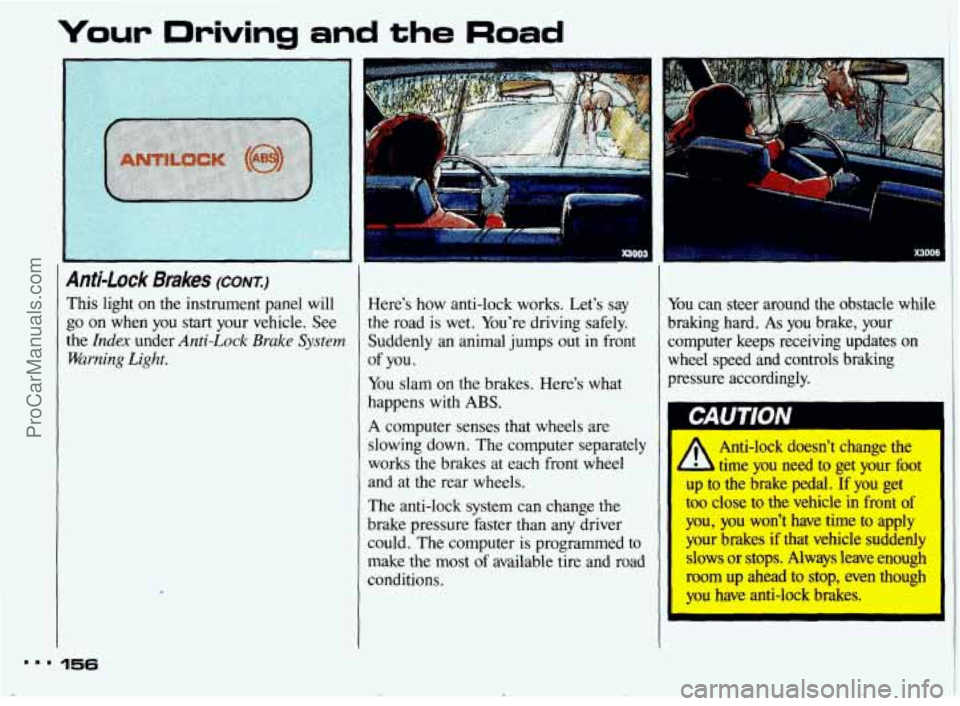
Your Driving and the Road
4nti-Lock Brakes (CONT.)
rhis light on the instrument panel will
;o on when you start your vehicle. See
he
Index under Anti-Lock Bruke System
iVarning Light.
-Iere's how anti-lock works. Let's say
he road is wet. You're driving safely.
Suddenly an animal jumps out in front
Y'ou slam on the brakes. Here's what
lappens with
ABS.
4 computer senses that wheels are
;lowing down. The computer separately
works the brakes at each front wheel
md at the rear wheels.
The anti-lock system can change the
)rake pressure faster than any driver
:ould.
The computer is programmed to
nake the most
of available tire and road
:onditions.
>f you.
'ou can steer around the obstacle while
raking hard.
As you brake, your
omputer keeps receiving updates on
{heel speed and controls braking
ressure accordingly.
1
A *,nti-lock doesn't change the
- --me you need to get your foot
up
to the brake pedal. If you get
too close to the vehicle
in front of
you, you won't have time to apply
your brakes
if that vehicle suddenly
slows
or stops. Always leave enough
room up ahead to
stop, even though
you have anti-lock brakes.
mmm 156
ProCarManuals.com
Page 170 of 322
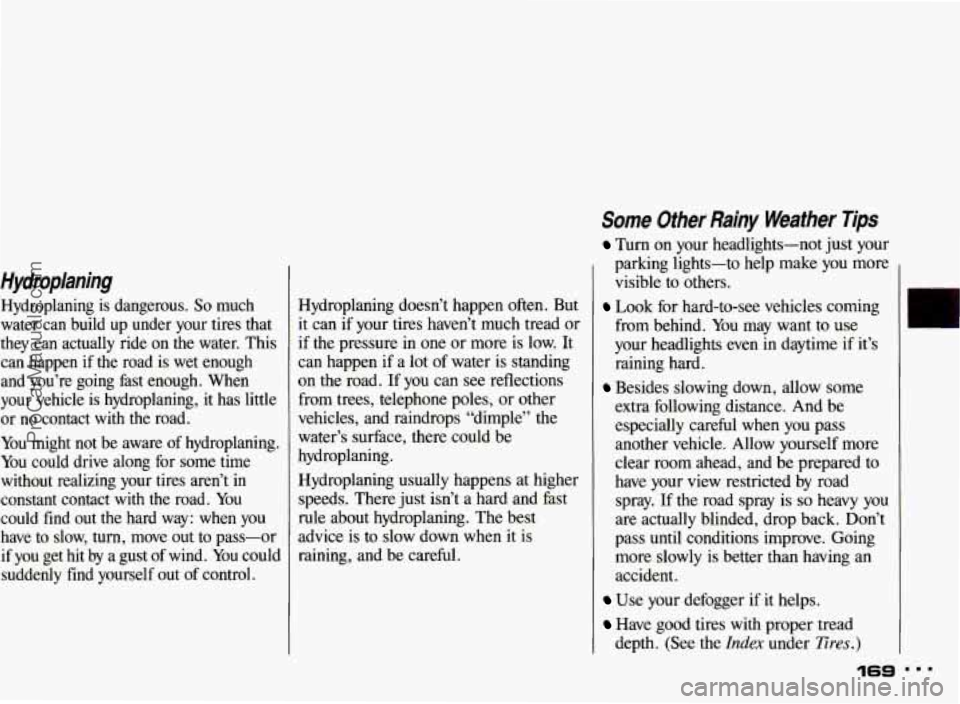
Some Other Rainy Weather Tips
Turn on your headlights-not just your
parking lights-to help make you more
visible to others.
Look for hard-to-see vehicles coming
from behind. You may want to use
your headlights even in daytime if it’s
raining hard.
Besides slowing down, allow some
extra following distance. And be
especially careful when you pass
another vehicle. Allow yourself more
clear room ahead, and be prepared to
have your view restricted by road
spray.
If the road spray is so heavy you
are actually blinded, drop back. Don’t
pass until conditions improve. Going
more slowly is better than having an
accident.
Use your defogger if it helps.
Have good tires with proper tread
depth. (See the
Index under Tires.)
Hydroplaning
Hydroplaning is dangerous. So much
water can build up under your tires that
they can actually ride on the water. This
can happen if the road is wet enough
and you’re going fast enough. When
your vehicle is hydroplaning, it has little
or no contact with the road.
You might not be aware
of hydroplaning.
You could drive along for some time
without realizing your tires aren’t in
constant contact with the road. You
could find out the hard way:
when you
have to slow, turn, move out to pass-or
if you get hit by a gust
of wind. You could
suddenly find yourself out of control. Hydroplaning doesn’t happen
often. But
it can if your tires haven’t much tread
or
if the pressure in one or more is low. It
can happen if a lot
of water is standing
on the road.
If you can see reflections
from trees, telephone poles, or other
vehicles, and raindrops “dimple” the
water’s surface, there could be
hydroplaning.
Hydroplaning usually happens at higher
speeds. There just isn’t a hard and fast
rule about hydroplaning. The best
advice is to slow down when it
is
raining, and be careful.
ProCarManuals.com
Page 175 of 322
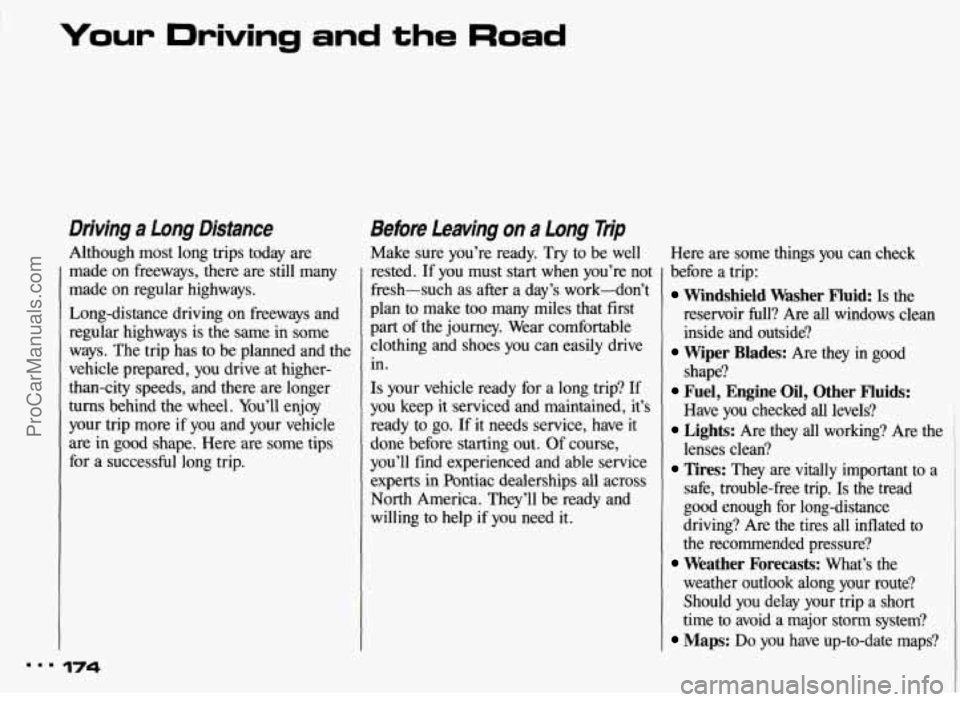
Your Driving and the Road
Driving a Long Distance
Although most long trips today are
made on freeways, there are still many
made on regular highways.
Long-distance driving on freeways and
regular highways
is the same in some
ways. The trip has to be planned and the
vehicle prepared, you drive
at higher-
than-city speeds, and there are longer
turns behind the wheel. You’ll enjoy
your trip more if
you and your vehicle
are in good shape. Here are some tips
for a successful long trip.
174
Before Leaving on a Long Trip
Make sure you’re ready. Try to be well Here are some things you can check
rested. If you must start when you’re not
fresh-such as after a day’s work-don’t
plan to make too many miles that first
part of the journey. Wear comfortable
clothing and shoes you can easily drive
in.
Is your vehicle ready for a long trip? If
you keep it serviced and maintained, it’s
ready to go. If it needs service, have it
done before starting out.
Of course,
you’ll find experienced and able service
experts in Pontiac dealerships all across
North America. They’ll be ready and
willing to help if you need it. before
a trip:
Windshield Washer Fluid: Is the
reservoir full? Are all windows clean
inside and outside?
shape?
Have you checked all levels?
lenses clean?
safe, trouble-free trip.
Is the tread
good enough for long-distance
driving? Are the tires all inflated to
the recommended pressure?
weather outlook along your route?
Should you delay your trip a short
time to avoid a major storm system?
Maps: Do you have up-to-date maps?
Wiper Blades: Are they in good
Fuel, Engine Oil, Other Fluids:
Lights: Are they all working? Are the
Tires: They are vitally important to a
Weather Forecasts: What’s the
ProCarManuals.com
Page 180 of 322
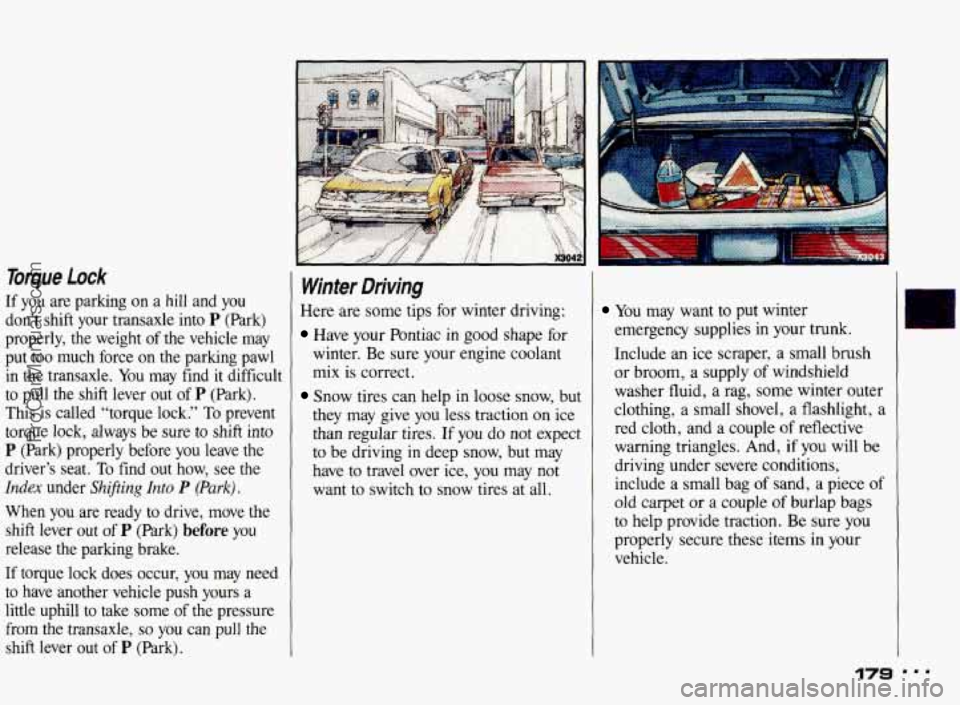
Toque Lock
If you are parking on a hill and you
don’t shift your transaxle into P (Park)
properly, the weight of the vehicle may
put too much force on the parking pawl in the transaxle.
You may find it difficult
to pull the shift lever out of P (Park).
This is called “torque lock.” To prevent
torque lock, always be sure
to shift into
P (Park) properly before you leave the
driver’s seat. To find out how, see the
Index under Shifing Into P (Park).
When you are ready to drive, move the
shift lever
out of P (Park) before you
release the parking brake.
If torque lock does occur, you may need
to have another vehicle push yours a
little uphill
to take some of the pressure
from the transaxle,
so you can pull the
shift lever out
of P (Park).
Winter Driving
Here are some tips for winter driving:
Have your Pontiac in good shape for
winter. Be sure your engine coolant
mix is correct.
Snow tires can help in loose snow, but
they may give
you less traction on ice
than regular tires.
If you do not expect
to be driving in deep snow, but may
have to travel over ice,
you may not
want to switch to snow tires at all.
I
You may want to put winter
emergency supplies in your trunk.
Include an ice scraper, a small brush
or broom, a supply of windshield
washer fluid, a rag,
some winter outer
clothing, a small shovel, a flashlight, a
red cloth, and a couple
of reflective
warning triangles. And,
if you will be
driving under severe conditions,
include a small bag of sand, a piece of
old carpet
or a couple of burlap bags
to help provide traction. Be sure
you
properly secure these items in your
vehicle.
17s ...
ProCarManuals.com
Page 209 of 322

Problems on the Road
I Engine Overheating (CONT.)
6. Start the engine and let it run until
you can feel the upper radiator hose
getting hot. Watch out for the engine
fan.
7. By this time, the coolant level inside
the radiator filler neck may be lower.
If the level is lower, add more of the
proper mix through the filler neck
until the level reaches the base of the
filler neck.
8. Then replace the pressure cap. Be
sure the arrows on the pressure cap
line up like this.
Ifa Tire Goes Flat
It’s unusual for a tire to “blow out”
while you’re driving, especially if you
maintain your tires properly. If air goes
out of a tire, it’s much more likely to
leak out slowly. But
if you should ever 1
have a “blowout:’ here are a few tips
about what to expect and what to do:
If a front tire fails, the flat tire will
create a drag that pulls
the vehicle
toward that side. Take your foot off the accelerator pedal and grip the steering
wheel firmly. Steer
to maintain lane
position,
then gently brake to a stop well
out of the traffic lane.
ProCarManuals.com
Page 210 of 322

A rear blowout, particularly on a curve,
acts much like a skid and may require
the same correction you'd use in a skid.
In any rear blowout, remove your foot from the accelerator pedal. Get the
vehicle under control by steering the
way you want the vehicle to
go. It may
be very bumpy and noisy, but you can
still steer, Gently brake to a stop, well
off the road
if possible.
If your tire goes flat, the next section
shows how to use your jacking
equipment to change a flat tire safely.
Air lnflator Sysfem
Some vehicles have an air inflator for
use in bringing tires up to the proper
pressure. The air inflator is located in
the trunk. The
ON switch will work
even with the ignition off. The air
inflator comes with
a kit that
includes a 20-foot hose and an air
pressure gage, as well as instructions
and special adapters for inflating things
like an air mattress or basketball.
Inflating something too much
can make it explode, and
you
or others could be injured. Be sure
to read the inflator instructions,
and inflate any object only
to its
1 recommended pressure.
1
I 209
ProCarManuals.com
Page 218 of 322

Don’t try to put the wheel cover on the
compact spare tire. It won’t
fit. Store the
wheel cover in the trunk until you have
replaced the compact spare tire with a
regular tire.
Wheel covers won’t fit on your
compact spare. If you try to put
a
wheel cover on your compact
spare, you could damage the cover
or the spare.
19. Store the flat tire as far forward in
the trunk as possible. Store the jack
and wheel wrench
in their
compartment in the trunk.
1 Storing a jack, a tire, or other
equipment in the passenger
compartment of the vehicle could
cause injury. In a sudden stop or
collision, loose equipment could
strike
someone. Store all these in
I the proper place.
The compact spare is for temporary use
only. Replace the compact spare tire
with a full-size tire as soon as you can.
See
Compact Spare Tire later in this
section.
Compact Spare Tire
Although the compact spare was fully
inflated when your vehicle was new, it
can lose air after a time. Check the
inflation pressure regularly. It should be
60 psi (420 kPa). The compact spare is
made to
go up to 3,000 miles (5 000 km),
so you can finish your trip and have
your full-size tire repaired
or replaced
where you want. Of course, it’s best to replace your spare with
a fill-size tire as
soon as you can. Your spare will last
longer and be
in good shape in case you
need it again.
r
ProCarManuals.com